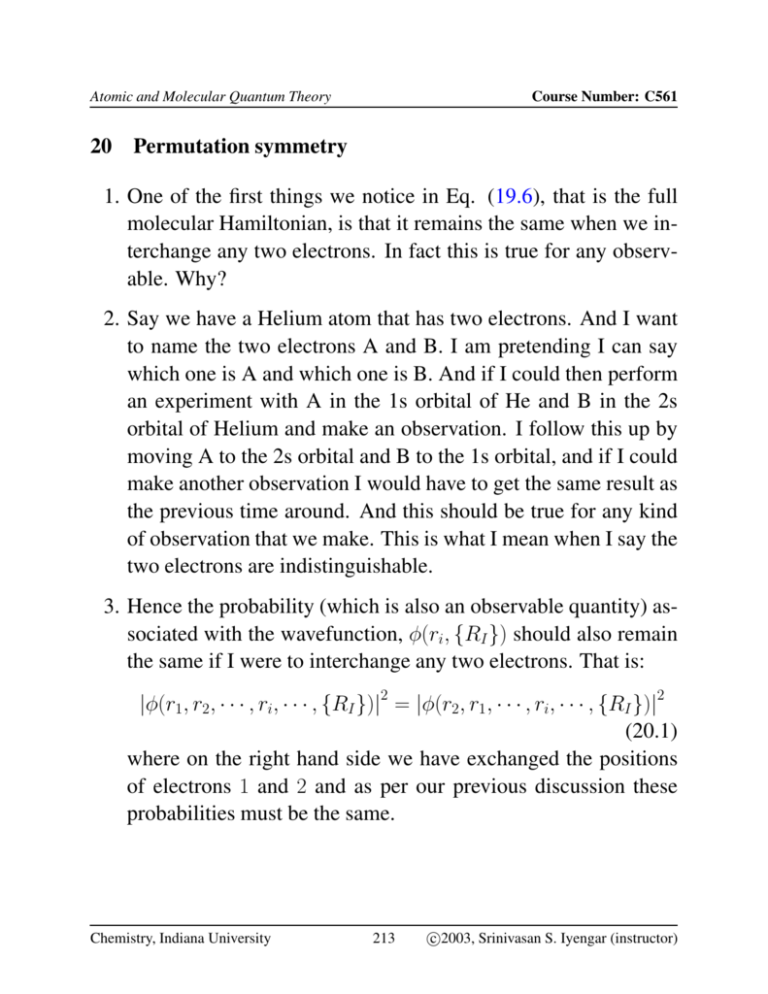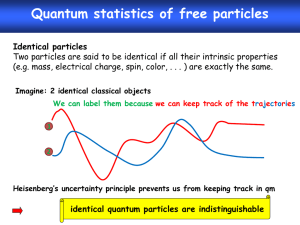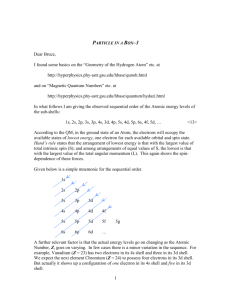Permutation symmetry, Slater determinants and
advertisement

Course Number: C561
Atomic and Molecular Quantum Theory
20 Permutation symmetry
1. One of the first things we notice in Eq. (19.6), that is the full
molecular Hamiltonian, is that it remains the same when we interchange any two electrons. In fact this is true for any observable. Why?
2. Say we have a Helium atom that has two electrons. And I want
to name the two electrons A and B. I am pretending I can say
which one is A and which one is B. And if I could then perform
an experiment with A in the 1s orbital of He and B in the 2s
orbital of Helium and make an observation. I follow this up by
moving A to the 2s orbital and B to the 1s orbital, and if I could
make another observation I would have to get the same result as
the previous time around. And this should be true for any kind
of observation that we make. This is what I mean when I say the
two electrons are indistinguishable.
3. Hence the probability (which is also an observable quantity) associated with the wavefunction, φ(ri, {RI }) should also remain
the same if I were to interchange any two electrons. That is:
|φ(r1, r2, · · · , ri, · · · , {RI })|2 = |φ(r2, r1 , · · · , ri, · · · , {RI })|2
(20.1)
where on the right hand side we have exchanged the positions
of electrons 1 and 2 and as per our previous discussion these
probabilities must be the same.
Chemistry, Indiana University
213
c
2003,
Srinivasan S. Iyengar (instructor)
Course Number: C561
Atomic and Molecular Quantum Theory
4. Hence the electronic wavefunction, φ(ri , {RI }), must satisfy the
following condition:
φ(r1, r2, · · · , ri, · · · , {RI }) = ±φ(r2, r1 , · · · , ri, · · · , {RI })
(20.2)
that is the wavefunction can either be symmetric (+) or antisymmetric (-) with exchange (or permutation) of particles.
5. It turns out that in nature we have two different kinds of particles. One set of particles have wavefunctions that are symmetric
with respect to exchange of particles. This set of particles are
called bosons. The reason they are called so is because they obey
what is known as the Bose-Einstein statistics. The other set of
particles that have wavefunctions that are anti-symmetric with
respect to exchange of particles are called fermions since they
obey Fermi-Dirac statistics. (These statistics are means that one
uses to find out how the energy levels are populated. Based on
the symmetry properties that these particles obey, that is symmetry with respect to permutation, the energy levels are populated
differently and these two statistics tell us how so.)
6. By contrast classical particles obey what is known as the MaxwellBoltzmann statistics.
Chemistry, Indiana University
214
c
2003,
Srinivasan S. Iyengar (instructor)
Course Number: C561
Atomic and Molecular Quantum Theory
7. Therefore, for bosons:
φB (r1, r2, · · · , ri , · · · , {RI }) = φB (r2, r1, · · · , ri , · · · , {RI })
(20.3)
and for fermions:
φF (r1, r2, · · · , ri, · · · , {RI }) = −φF (r2, r1, · · · , ri, · · · , {RI })
(20.4)
where we have used subscript B to represent boson and subscript
F to represent fermions.
8. One more important result that comes in from relativistic quantum mechanics is that fermions can only have half-integer spins
and bosons can only have integer spins. This is something that
one cannot get from non-relativistic quantum mechanics, hence
we will take this result for granted at this time.
9. Electrons, protons and neutrons are fermions. Photons are bosons.
In addition, a collection of two fermions has a net spin of 0 or 1
and hence is a boson. For this reason a 4He, since it has an even
number of electrons, protons and neutrons, is a boson. We will
see more on this a little later.
Chemistry, Indiana University
215
c
2003,
Srinivasan S. Iyengar (instructor)
Course Number: C561
Atomic and Molecular Quantum Theory
10. Another important result that we find from permutation symmetry of fermions is that two fermions cannot be at the same point,
since if r1 is the position of electrons 1 and 2
φF (r1, r1, · · · , ri , · · · , {RI }) = −φF (r1, r1, · · · , ri , · · · , {RI }) = 0.
(20.5)
Hence, if two fermions were to occupy the same position, the
corresponding state wavefunction would have to be zero, if not it
would violate the permutation anti-symmetry property of fermions.
This is called the Pauli’s exclusion principle and states that two
electrons (or more generally fermions) cannot occupy the same
point in space simultaneously and hence cannot have the same
set of quantum numbers. This is a very powerful result that we
will get back to in a little while, but more importantly this is a
result that really rules the whole of chemistry and is obtained
entirely from permutation symmetry.
11. As for bosons, two bosons can occupy the same position since:
φB (r1, r1, · · · , ri , · · · , {RI }) = φB (r1, r1, · · · , ri , · · · , {RI })
(20.6)
does not have to be zero in this case. Thus bosons can occupy
the same point in space and can occupy the same energy level,
etc and hence are very sociable particles unlike fermions. This
leads to a very important property at low temperatures. Since,
many bosons can occupy the same energy level, a collection of
these at low temperatures can condense together to form a BoseEinstein condensate. Probably many of you have heard about
this very new and interesting phenomenon. (New in the sense
that it was first seen experimentally in 1995 but it was in fact
Chemistry, Indiana University
216
c
2003,
Srinivasan S. Iyengar (instructor)
Course Number: C561
Atomic and Molecular Quantum Theory
predicted by Bose back in 1920, using permutation symmetry
just as we did here!!)
12. Classical particles obey Maxwell-Boltzmann statistics and have
intermediate sociability :-), between fermions and bosons.
Chemistry, Indiana University
217
c
2003,
Srinivasan S. Iyengar (instructor)
Course Number: C561
Atomic and Molecular Quantum Theory
21 The Independent particle approximation: Slater determinants
1. In this section we will go through a very important concept: the
independent particle approximation. This approximation is at
the heart of many methods such as Hartree-Fock theory and
Density functional theory which are very popular methods to
solve the electronic Schrödinger Equation, Eq. (19.8).
2. The first assumption within the independent particle approximation is each particle is independent, ie each particle is in a different orbital, so that we can write the wavefunction in a product
form:
φ(r1 , r2, · · · , ri , · · · , {RI }) = η1(r1)η2(r2) · · · ηN (rN )
(21.1)
where {ηi} are N orbitals (we assume there are N electrons as
well) and we have omitted the dependence on {RI } on the right
hand side. This equation means that electron 1, whose position
is given by r1 is in the orbital η1, electron 2 whose position is
given by r2 is in orbital η2 and so on. The approximate form of
the wavefunction represented in Eq. (21.1) is often known as the
Hartree product.
3. However, Eq. (21.1) is not an acceptable wavefunction for Fermions
since it lacks the anti-symmetry property of Fermions. How do
we know this? Let us permute the coordinates for electrons 1
and 2 (that is interchange the positions of electron 1 and 2) using a permutation operator P1,2, and see what happens:
P1,2 [φ(r1, r2 , · · · , ri, · · · , {RI })] = P1,2 [η1(r1)η2(r2) · · · ηN (rN )]
Chemistry, Indiana University
218
c
2003,
Srinivasan S. Iyengar (instructor)
Course Number: C561
Atomic and Molecular Quantum Theory
= [η1(r2)η2(r1) · · · ηN (rN )]
6= ± [η1(r1)η2(r2) · · · ηN (rN )]
(21.2)
Hence while Eq. (21.1) is a useful independent particle approximation for the wavefunction, but it does not have the suitable
properties to represent Fermionic systems.
4. To see that Eq. (21.1) does have the attractive independent particle property, in that all the N particles represented in Eq. (21.1)
are independent of each other, we note that the probability associated with the wavefunction has the following product form:
|φ(r1, r1 , · · · , ri , · · · , {RI })|2 = |η1 (r1)|2|η2(r2)|2 · · · |ηN (rN )|2
(21.3)
and from probability theory we remember that two events A and
B are considered independent of each other if the probability of
both A and B occurring simultaneously is equal to the product
of the probability of A occurring times the probability of B occurring. Eq. (21.3) has a similar mathematical form. And for
this reason the approximation in Eq. (21.1) is termed as the independent particle approximation.
5. So, Eq. (21.1) is useful but can we make it better, by including
permutation symmetry in it?
6. Let us now consider a new function Φ which is a sum of two
terms similar to Eq. (21.1):
Φ = [η1(r1)η2(r2) · · · ηi (ri ) · · · ηj (rj ) · · ·] −
[η1(r1)η2(r2) · · · ηi (rj ) · · · ηj (ri) · · ·]
Chemistry, Indiana University
219
(21.4)
c
2003,
Srinivasan S. Iyengar (instructor)
Course Number: C561
Atomic and Molecular Quantum Theory
where in the second term we have just interchanged particles i
and j. Equation (21.4) does satisfy permutation symmetry but
only for particle i and j since:
Pi,j Φ = Pi,j {[η1(r1)η2 (r2) · · · ηi(ri ) · · · ηj (rj ) · · ·] −
[η1 (r1)η2(r2) · · · ηi(rj ) · · · ηj (ri ) · · ·]}
= [η1 (r1)η2(r2) · · · ηi(rj ) · · · ηj (ri ) · · ·] −
[η1 (r1)η2(r2) · · · ηi(ri ) · · · ηj (rj ) · · ·]
= −Φ
(21.5)
However, Eq. (21.4) obeys permutation symmetry only for particles i and j and no other set of particles. (We can convince
ourselves that this is true by interchanging particle 1 and particle
2 and we would find that permutation symmetry is not obeyed.
Please do this for homework.)
7. Can we generalize Eq. (21.4) so that permutation symmetry is
obeyed for all set of particles. Let us propose the following definition for the wavefunction:
Φ=
X
p
(−1)p {η1 (r1)η2(r2) · · · ηi(ri ) · · · ηj (rj ) · · ·}
(21.6)
where the sum is over all possible permutations. For each permutation there is a negative sign introduced by way of the factor
(−1)p. Since all permutations are included (instead of just one in
Eq. (21.4)) we note that this equation is indeed a generalization
of Eq. (21.4).
8. Let us illustrate Eq. (21.6) on the board for a few simple cases
and convince ourselves that Eq. (21.6) indeed obeys permutation symmetry.
Chemistry, Indiana University
220
c
2003,
Srinivasan S. Iyengar (instructor)
Course Number: C561
Atomic and Molecular Quantum Theory
9. As we will see on the board Eq. (21.6) is in fact a short hand notation for a determinant. Hence the wavefunction in Eq. (21.6)
has a determinantal form. This was first noted by Slater and
hence is called the Slater determinant.
10. The Slater determinant in Eq. (21.6) is closest a Fermionic system can get to an independent particle system, without violating
permutation symmetry.
11. In fact, we can also write Eq. (21.6) as: which looks more like a
determinant as we saw on the board for the simpler cases.
12. It is important to note here that both in Hartree-Fock theory and
in density functional theory, two commonly used approaches in
electronic structure theory, the wavefunction has a Slater determinant form. This form actually affords a great deal of simplification to Eq. (19.8)
Chemistry, Indiana University
221
c
2003,
Srinivasan S. Iyengar (instructor)







